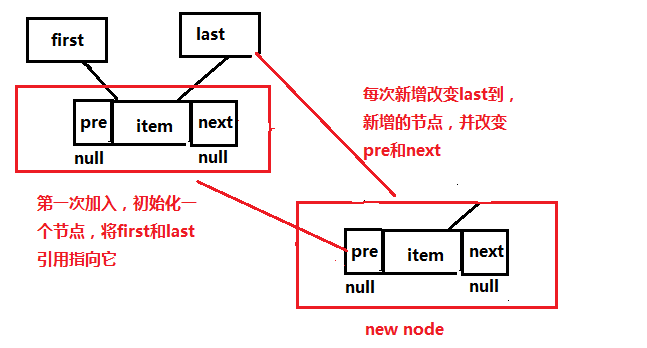LinkedList 源码分析
1 2 3 4 5 6 7 8 9 10 11 12 13 14 15 16 17 18 19 20 21 22 23 24 25 26 27 28 29 30 31 32 33 34 35 36 37 38 39 40 41 42 43 44 45 46 47 48 49 50 51 52 53 54 55 56 57 58 59 60 61 62 63 64 65 66 67 68 69 70 71 72 73 74 75 76 77 78 79 80 81 82 83 84 85 86 87 88 89 90 91 92 93 94 95 96 97 98 99 100 101 102 103 104 105 106 107 108 109 110 111 112 113 114 115 116 117 118 119 120 121 122 123 124 | LinkedList :双向链表结构, 内部存在frist节点 和 last节点。通过改变 首节点和 尾节点的引用来实现新增和修改有一个内部类: //节点类,内部包括前节点和后节点,和数据项 // 构造的时候把前和后节点,数据项初始化 private static class Node<E> { E item; Node<E> next; Node<E> prev; Node(Node<E> prev, E element, Node<E> next) { this.item = element; this.next = next; this.prev = prev; } } //大小默认是0 transient int size = 0; /** * Pointer to first node. 头节点 * Invariant: (first == null && last == null) || * (first.prev == null && first.item != null) */ transient Node<E> first; /** * Pointer to last node. 尾节点 * Invariant: (first == null && last == null) || * (last.next == null && last.item != null) */ transient Node<E> last; /** * Constructs an empty list. */ public LinkedList() { } /** * Constructs an empty list.构造方法默认空 */ public LinkedList() { } public boolean add(E e) { linkLast(e); return true; } // 新建一个node,前节点指向last节点,后节点为null。将新建node为尾节点last public boolean add(E e) { linkLast(e); // return true; } //追加一个节点为尾节点 void linkLast(E e) { final Node<E> l = last; final Node<E> newNode = new Node<>(l, e, null); last = newNode; if (l == null) first = newNode; else l.next = newNode; size++; modCount++; } // 删除一个元素, 从头节点遍历每一个节点,直到找到并删除 public boolean remove(Object o) { if (o == null) { for (Node<E> x = first; x != null; x = x.next) { if (x.item == null) { unlink(x); return true; } } } else { for (Node<E> x = first; x != null; x = x.next) { if (o.equals(x.item)) { unlink(x); return true; } } } return false; } //按索引插入,根据索引大小 /2 确定向前遍历,还是向后遍历,得到要插入的node,将该node的前后节点和新节点改变 public void add(int index, E element) { checkPositionIndex(index); if (index == size) linkLast(element); else linkBefore(element, node(index)); } void linkBefore(E e, Node<E> succ) { // assert succ != null; final Node<E> pred = succ.prev; final Node<E> newNode = new Node<>(pred, e, succ); succ.prev = newNode; if (pred == null) first = newNode; else pred.next = newNode; size++; modCount++; } |
图如下:






【推荐】还在用 ECharts 开发大屏?试试这款永久免费的开源 BI 工具!
【推荐】国内首个AI IDE,深度理解中文开发场景,立即下载体验Trae
【推荐】编程新体验,更懂你的AI,立即体验豆包MarsCode编程助手
【推荐】轻量又高性能的 SSH 工具 IShell:AI 加持,快人一步
· 如何在 .NET 中 使用 ANTLR4
· 后端思维之高并发处理方案
· 理解Rust引用及其生命周期标识(下)
· 从二进制到误差:逐行拆解C语言浮点运算中的4008175468544之谜
· .NET制作智能桌面机器人:结合BotSharp智能体框架开发语音交互
· 后端思维之高并发处理方案
· 千万级大表的优化技巧
· 在 VS Code 中,一键安装 MCP Server!
· 想让你多爱自己一些的开源计时器
· 10年+ .NET Coder 心语 ── 继承的思维:从思维模式到架构设计的深度解析